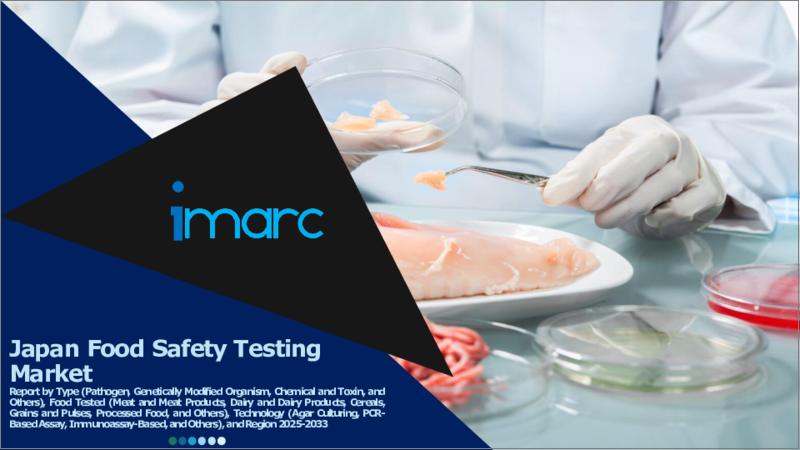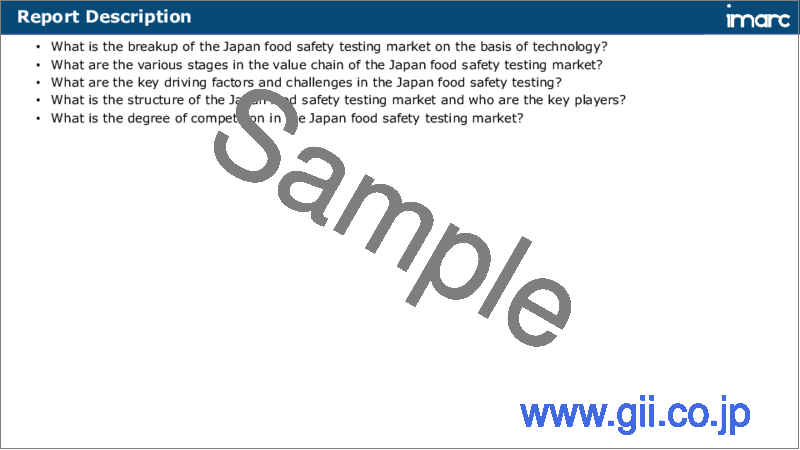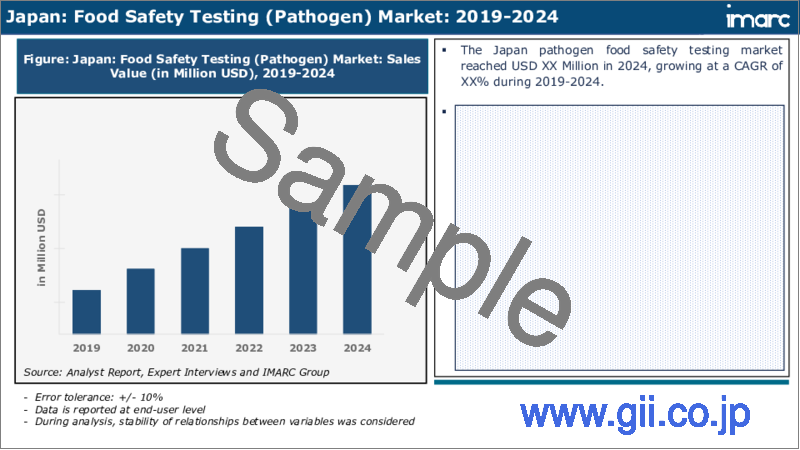|
|
市場調査レポート
商品コード
1609766
日本の食品安全検査市場レポート:タイプ、検査食品、技術、地域別、2024年~2032年Japan Food Safety Testing Market Report by Type, Food Tested, Technology, and Region 2024-2032 |
||||||
カスタマイズ可能
|
|||||||
| 日本の食品安全検査市場レポート:タイプ、検査食品、技術、地域別、2024年~2032年 |
|
出版日: 2024年12月05日
発行: IMARC
ページ情報: 英文 120 Pages
納期: 5~7営業日
|
- 全表示
- 概要
- 目次
日本の食品安全検査市場の市場規模は2023年に8億9,088万米ドルに達しました。今後、IMARC Groupは、市場は2032年までに15億8,356万米ドルに達し、2024年から2032年の間に6.10%の成長率(CAGR)を示すと予測しています。一般人における食中毒の増加、食品製造業者に特定の食品安全基準の遵守を義務付ける厳しい政府命令、飲食品セクターの大幅な拡大などが市場を前進させる主な要因です。
本レポートで扱う主な質問
- 日本の食品安全検査市場はこれまでどのように推移し、今後どのように推移するのか?
- COVID-19の日本の食品安全検査市場への影響は?
- 日本の食品安全検査市場のタイプ別の内訳は?
- 日本の食品安全検査市場の検査食品別の内訳は?
- 日本の食品安全検査市場の技術別の内訳は?
- 日本の食品安全検査市場のバリューチェーンにはどのような段階があるか?
- 日本の食品安全検査における主な促進要因と課題は何か?
- 日本の食品安全検査市場の構造と主要プレーヤーは?
- 日本の食品安全検査市場における競合の程度は?
目次
第1章 序文
第2章 調査範囲と調査手法
- 調査の目的
- ステークホルダー
- データソース
- 市場推定
- 調査手法
第3章 エグゼクティブサマリー
第4章 日本の食品安全検査市場:イントロダクション
- 概要
- 市場力学
- 業界動向
- 競合情報
第5章 日本の食品安全検査市場情勢
- 過去および現在の市場動向(2018~2023年)
- 市場予測(2024~2032年)
第6章 日本の食品安全検査市場:タイプ別の内訳
- 病原体
- 遺伝子組み換え生物
- 化学物質と毒素
- その他
第7章 日本の食品安全検査市場:食品検査別の内訳
- 肉および肉製品
- 乳製品
- 穀物、穀類、豆類
- 加工食品
- その他
第8章 日本の食品安全検査市場:技術別の内訳
- 寒天培養
- PCRベースのアッセイ
- イムノアッセイベース
- その他
第9章 日本の食品安全検査市場:競合情勢
- 概要
- 市場構造
- 市場プレーヤーのポジショニング
- 主要成功戦略
- 競合ダッシュボード
- 企業評価象限
第10章 主要企業のプロファイル
第11章 日本の食品安全検査市場:業界分析
- 促進要因・抑制要因・機会
- ポーターのファイブフォース分析
- バリューチェーン分析
第12章 付録
Japan food safety testing market size reached US$ 890.88 Million in 2023. Looking forward, IMARC Group expects the market to reach US$ 1,583.56 Million by 2032, exhibiting a growth rate (CAGR) of 6.10% during 2024-2032. The increasing occurrence of foodborne diseases among the general population, strict government mandates necessitating food producers to adhere to particular food safety criteria, and substantial expansion in the food and beverage sector are among the primary drivers propelling the market forward.
Food testing involves the examination of food items to assess their chemical, physical, and microbiological attributes, utilizing a range of analytical methods to guarantee the safety, nutritional value, and superior quality of food products. Its primary function is to identify harmful substances or pathogens present in food, ensuring its suitability for consumption while adhering to regulatory and industry standards. Food testing also ensures accurate labeling of food products, encompassing details about nutritional composition, allergens, and country of origin. Moreover, food testing is instrumental in research and development endeavors, facilitating the creation of new food items, enhancements to existing products, and the assessment of novel ingredients and technologies. Consequently, it serves as a pivotal mechanism in upholding consistent quality in food products, ultimately contributing to improved taste, texture, and overall appearance.
Japan Food Safety Testing Market Trends:
The Japanese food safety testing market is significantly influenced by the heightened strictness of food safety regulations implemented by regulatory bodies in numerous countries, in response to the increasing prevalence of unsatisfactory hygiene practices during food production processes. Consequently, the escalating instances of food adulteration and contamination, leading to potential health risks for consumers, have driven the adoption of more stringent testing procedures. The surge in demand for convenience foods, owing to busy lifestyles and evolving dietary preferences, has resulted in a notable rise in the number of food processing and manufacturing facilities, thereby bolstering the market demand. Furthermore, the continuous advancements in food safety testing technologies, including PCR-based methods, immunoassays, and biosensors, are generating lucrative prospects within the market. Additionally, extensive research and development (R&D) activities, coupled with mergers and acquisitions (M&As), as well as partnerships and collaborations among key market players, are contributing to the overall growth of the market. Factors, including the rapid pace of industrialization, the emerging trend of organic food consumption, and the increasing health consciousness among the population, are anticipated to fuel the market growth over the forecasted period.
Japan Food Safety Testing Market Segmentation:
Type Insights:
- Pathogen
- Genetically Modified Organism
- Chemical and Toxin
- Others
Food Tested Insights:
- Meat and Meat Products
- Dairy and Dairy Products
- Cereals, Grains and Pulses
- Processed Food
- Others
Technology Insights:
- Agar Culturing
- PCR-Based Assay
- Immunoassay-Based
- Others
Competitive Landscape:
The market research report has also provided a comprehensive analysis of the competitive landscape. Competitive analysis such as market structure, key player positioning, top winning strategies, competitive dashboard, and company evaluation quadrant has been covered in the report. Also, detailed profiles of all major companies have been provided.
Key Questions Answered in This Report:
- How has the Japan food safety testing market performed so far and how will it perform in the coming years?
- What has been the impact of COVID-19 on the Japan food safety testing market?
- What is the breakup of the Japan food safety testing market on the basis of type?
- What is the breakup of the Japan food safety testing market on the basis of food tested?
- What is the breakup of the Japan food safety testing market on the basis of technology?
- What are the various stages in the value chain of the Japan food safety testing market?
- What are the key driving factors and challenges in the Japan food safety testing?
- What is the structure of the Japan food safety testing market and who are the key players?
- What is the degree of competition in the Japan food safety testing market?
Table of Contents
1 Preface
2 Scope and Methodology
- 2.1 Objectives of the Study
- 2.2 Stakeholders
- 2.3 Data Sources
- 2.3.1 Primary Sources
- 2.3.2 Secondary Sources
- 2.4 Market Estimation
- 2.4.1 Bottom-Up Approach
- 2.4.2 Top-Down Approach
- 2.5 Forecasting Methodology
3 Executive Summary
4 Japan Food Safety Testing Market - Introduction
- 4.1 Overview
- 4.2 Market Dynamics
- 4.3 Industry Trends
- 4.4 Competitive Intelligence
5 Japan Food Safety Testing Market Landscape
- 5.1 Historical and Current Market Trends (2018-2023)
- 5.2 Market Forecast (2024-2032)
6 Japan Food Safety Testing Market - Breakup by Type
- 6.1 Pathogen
- 6.1.1 Overview
- 6.1.2 Historical and Current Market Trends (2018-2023)
- 6.1.3 Market Forecast (2024-2032)
- 6.2 Genetically Modified Organism
- 6.2.1 Overview
- 6.2.2 Historical and Current Market Trends (2018-2023)
- 6.2.3 Market Forecast (2024-2032)
- 6.3 Chemical and Toxin
- 6.3.1 Overview
- 6.3.2 Historical and Current Market Trends (2018-2023)
- 6.3.3 Market Forecast (2024-2032)
- 6.4 Others
- 6.4.1 Historical and Current Market Trends (2018-2023)
- 6.4.2 Market Forecast (2024-2032)
7 Japan Food Safety Testing Market - Breakup by Food Tested
- 7.1 Meat and Meat Products
- 7.1.1 Overview
- 7.1.2 Historical and Current Market Trends (2018-2023)
- 7.1.3 Market Forecast (2024-2032)
- 7.2 Dairy and Dairy Products
- 7.2.1 Overview
- 7.2.2 Historical and Current Market Trends (2018-2023)
- 7.2.3 Market Forecast (2024-2032)
- 7.3 Cereals, Grains and Pulses
- 7.3.1 Overview
- 7.3.2 Historical and Current Market Trends (2018-2023)
- 7.3.3 Market Forecast (2024-2032)
- 7.4 Processed Food
- 7.4.1 Overview
- 7.4.2 Historical and Current Market Trends (2018-2023)
- 7.4.3 Market Forecast (2024-2032)
- 7.5 Others
- 7.5.1 Historical and Current Market Trends (2018-2023)
- 7.5.2 Market Forecast (2024-2032)
8 Japan Food Safety Testing Market - Breakup by Technology
- 8.1 Agar Culturing
- 8.1.1 Overview
- 8.1.2 Historical and Current Market Trends (2018-2023)
- 8.1.3 Market Forecast (2024-2032)
- 8.2 PCR-Based Assay
- 8.2.1 Overview
- 8.2.2 Historical and Current Market Trends (2018-2023)
- 8.2.3 Market Forecast (2024-2032)
- 8.3 Immunoassay-Based
- 8.3.1 Overview
- 8.3.2 Historical and Current Market Trends (2018-2023)
- 8.3.3 Market Forecast (2024-2032)
- 8.4 Others
- 8.4.1 Historical and Current Market Trends (2018-2023)
- 8.4.2 Market Forecast (2024-2032)
9 Japan Food Safety Testing Market - Competitive Landscape
- 9.1 Overview
- 9.2 Market Structure
- 9.3 Market Player Positioning
- 9.4 Top Winning Strategies
- 9.5 Competitive Dashboard
- 9.6 Company Evaluation Quadrant
10 Profiles of Key Players
- 10.1 Company A
- 10.1.1 Business Overview
- 10.1.2 Product Portfolio
- 10.1.3 Business Strategies
- 10.1.4 SWOT Analysis
- 10.1.5 Major News and Events
- 10.2 Company B
- 10.2.1 Business Overview
- 10.2.2 Product Portfolio
- 10.2.3 Business Strategies
- 10.2.4 SWOT Analysis
- 10.2.5 Major News and Events
- 10.3 Company C
- 10.3.1 Business Overview
- 10.3.2 Product Portfolio
- 10.3.3 Business Strategies
- 10.3.4 SWOT Analysis
- 10.3.5 Major News and Events
- 10.4 Company D
- 10.4.1 Business Overview
- 10.4.2 Product Portfolio
- 10.4.3 Business Strategies
- 10.4.4 SWOT Analysis
- 10.4.5 Major News and Events
- 10.5 Company E
- 10.5.1 Business Overview
- 10.5.2 Product Portfolio
- 10.5.3 Business Strategies
- 10.5.4 SWOT Analysis
- 10.5.5 Major News and Events
11 Japan Food Safety Testing Market - Industry Analysis
- 11.1 Drivers, Restraints, and Opportunities
- 11.1.1 Overview
- 11.1.2 Drivers
- 11.1.3 Restraints
- 11.1.4 Opportunities
- 11.2 Porters Five Forces Analysis
- 11.2.1 Overview
- 11.2.2 Bargaining Power of Buyers
- 11.2.3 Bargaining Power of Suppliers
- 11.2.4 Degree of Competition
- 11.2.5 Threat of New Entrants
- 11.2.6 Threat of Substitutes
- 11.3 Value Chain Analysis





